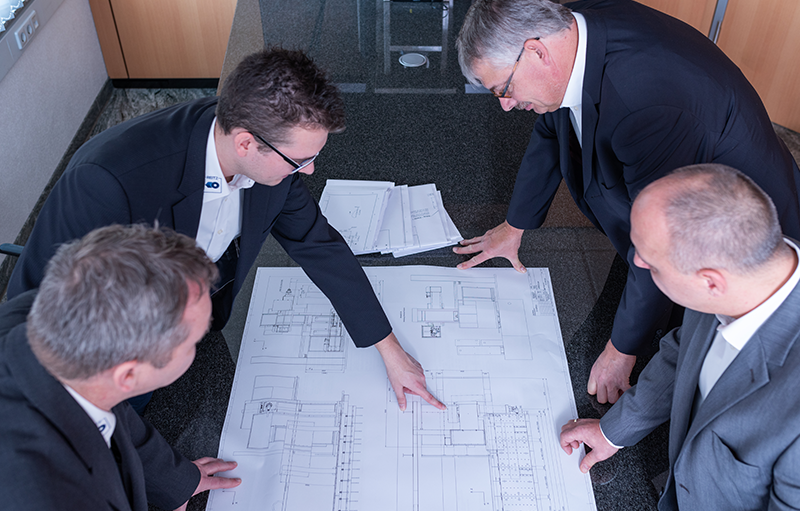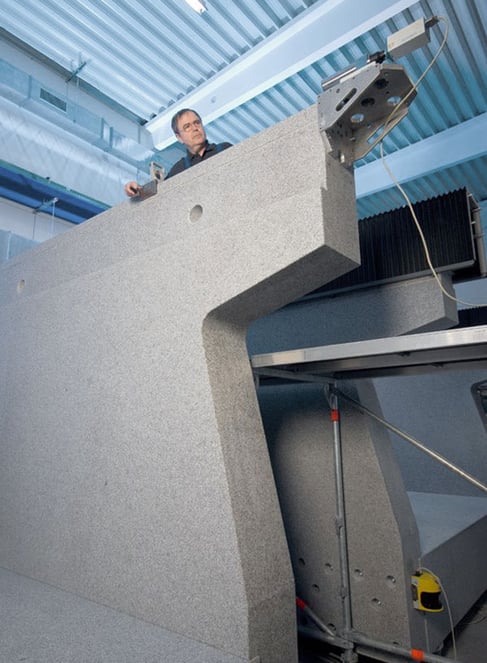It is still widely, and erroneously, believed that granite is only used as a machine foundation for high-end coordinate measuring equipment. However, this belief has long been considered outdated. The natural stone granite has also embarked on its triumphal march in general machine construction, especially in the field of honing, grinding, milling and electrical discharge machining. These machines in particular are not usually placed in an air-conditioned environment, are themselves often a powerful source of heat, and yet are still expected to work with consistent precision. Reitz offers tailor-made solutions for this. .

We benefit from the expertise and motivation of our staff as well as from the state-of-the-art technologies and processing machines in use at our production centre in Asslar
Reitz is one of the leading companies in the processing of natural stone for machine construction in Europe with more than 30 years of experience. The company processes up to 18,000 tons of granite here every year. The granite is mined in Europe and Africa, and processed in the company on internally developed CNC machines with the appropriate diamond tools. Customers receive tailor-made solutions as a complete package from a single source.
Granite expands only half as much as steel
The main advantage of granite comes into its own when it is used as a machine foundation. The linear coefficient of expansion at approximately 6 x 10-6 is only half that of steel (12x10-6). Then there is the much lower conductivity than that of steel, high vibration damping and abrasion resistance plus the specific density of 2.8 g/cm³, which is almost the same as that of aluminium (2.7 g/cm³). Steel and cast iron, on the other hand, are 7.85 and 7.15 g/cm³ respectively.
If you compare, for instance, a standard machine bed with a length of 3 metres at a temperature increase of just 1° Celsius, this will result in an expansion in length of more than 3/10 of a mm. In combination with the higher thermal conductivity of steel, a steel bed will react faster and more intensively to changes in temperature than a granite bed will, and permanently changes its geometry.
Attempts are often made to correct the changes in geometry by thermal expansion with compensation software. However, this has only limited success since every component requires highly complex and component-specific calculation models because of their geometry, the various heat influences (e.g. environment, workpiece, drive technology) and temperature layering.
The natural stone specialist Reitz is receiving more and more enquiries from companies that traditionally work with steel or cast iron machine foundations but who want to improve the accuracy of their machines due to the market's increasing requirements.
.

XXL granite machine foundation by Reitz
The planarity tolerance of granite ensures the maximum accuracy
When it comes to precision, the planarity tolerance is just as important as the thermodynamics. Reitz processes granite with an accuracy of < 1 µm/m, and so easily meets the DIN 876 requirement for accuracy level 00. The same applies for vibration behaviour. Granite has a lower natural frequency than metallic materials, which leads to a rapid reduction of the oscillation amplitude during vibration transmissions.
Althought it might be assumed that natural stone machine foundations are extremely expensive, this is not the case. In their projects, the experts of the natural stone specialist Reitz prove that the prices for customer-specific machine foundations made of granite are similar to those for cast iron or steel with the same accuracies.
It goes without saying that the use of granite blocks for machine beds requires a high level of knowledge and experience, from selection of the raw stone material, construction of the machine frame, professional stone processing, and measurement and assembly of the connecting elements, right the way through to installation on the customer's premises.

Application of the connecting elements requires a high level of expertise and experience.
Joining the individual components such as the base plate, truss and quill in particular requires a tremendous amount of expertise and experience, and is achieved with screw connections and by bonding. The same applies to the attachment of the stainless steel T-slot rails in the milled recesses of the granite or fixation of the often numerous thread inserts using two-compound adhesive to connect the components provided by the customer to the granite base plate.





